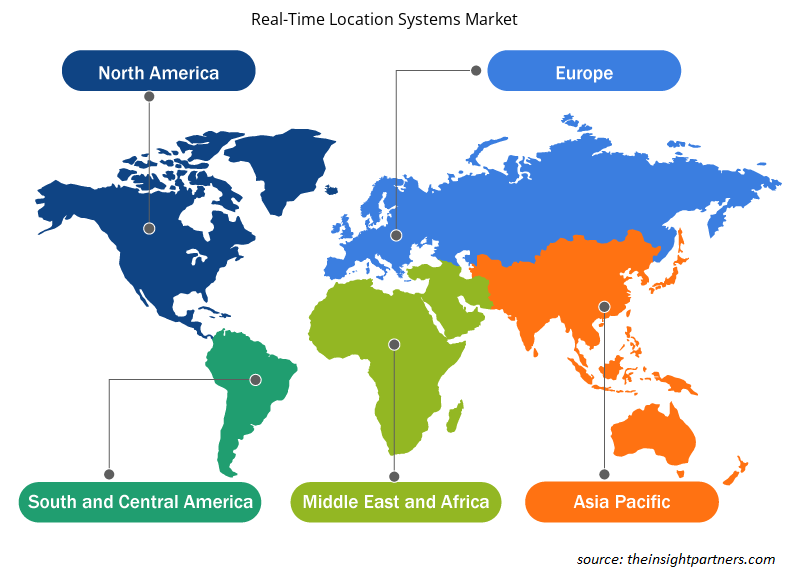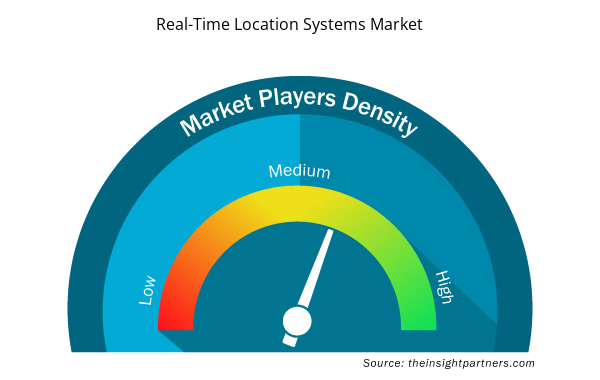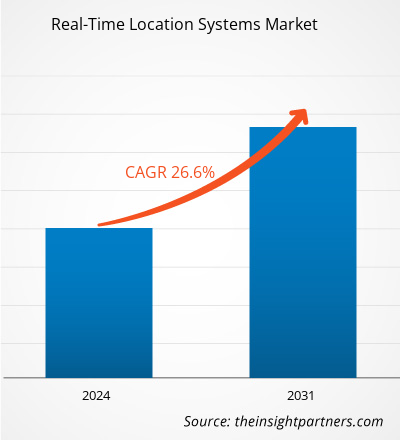实时定位系统市场规模预计将从 2023 年的 61.6 亿美元增至 2031 年的 407.0 亿美元。预计 2023-2031 年市场复合年增长率将达到 26.6%。医疗保健领域对 RTLS 的使用日益增多,这很可能成为市场趋势。
实时定位系统市场分析
全球范围内对联网设备的需求正在不断增长,包括智能手机、平板电脑和各种可穿戴设备,如智能手表、健身追踪器、VR 耳机、联网眼镜、智能珠宝和蓝牙耳机。智能手机和平板电脑可帮助用户实时准确地跟踪位置信息。这些设备可帮助用户了解实时交通状况并找到到达目的地的最快路线。它还帮助父母通过不同的位置跟踪应用程序监控孩子的活动。因此,智能手机和平板电脑的采用正在大幅增加。根据全球移动通信系统协会 (GSMA) 的数据,2022 年全球智能手机采用率为 76%,智能手机连接总数为 64 亿。预计到 2030 年,采用率将上升到 92%,全球连接数将达到 90 亿。根据同一报告,北美的智能手机普及率在 2022 年为 84%,预计到 2030 年将增长至 90%。同样,欧洲的智能手机普及率将从 2022 年的 84% 增长到 2030 年的 91%。在渗透率较低的撒哈拉以南非洲市场,智能手机普及率预计将从 2022 年的 51% 增长到 2030 年的 87%。
实时定位系统市场概览
实时定位系统市场大致分为五大区域:北美、欧洲、亚太地区 (APAC)、中东和非洲 (MEA) 和南美 (SAM)。2023 年,北美占据最大市场份额,其次是欧洲和亚太地区。预计 2023 年至 2031 年期间,亚太地区的复合年增长率最高。
预测期内,印度和中国等发展中经济体对实时定位系统的需求增加,预计将为亚太地区的市场参与者创造丰厚的机会。制造业、零售业和物流业的不断发展提高了对资产跟踪的需求,从而推动了该地区对实时定位系统的需求。上述行业对 RTLS 和 SLAM 的需求不断增长,鼓励市场参与者为客户提供先进的解决方案。据中国国务院称,中国零售业蓬勃发展,2023 年销售额将比上年增长 11%,达到 2.24 万亿美元。这些国家对先进技术的需求不断增长,预计将推动亚太地区实时定位系统市场的增长。
定制此报告以满足您的需求
您可以免费定制任何报告,包括本报告的部分内容、国家级分析、Excel 数据包,以及为初创企业和大学提供优惠和折扣
- 获取此报告的关键市场趋势。这个免费样品将包括数据分析,从市场趋势到估计和预测。
实时定位系统市场驱动因素和机遇
电子商务行业蓬勃发展
自 COVID-19 疫情爆发以来,全球网络购物激增。近年来,电子商务销售额出现了显着增长。根据国际航空运输协会 (IATA) 的数据,2021 年,有 21.4 亿人(即世界人口的约 27.6%)从在线门户网站购物。此外,亚太地区引领全球电子商务市场,中国占区域市场增长的很大一部分。根据国际贸易管理局的数据,中国是世界上最大的电子商务市场,占全球交易量的约 50%。2021 年,该国通过电子商务行业创造了约 1.5 万亿美元的收入,成为全球最大的电子商务市场。此外,欧洲是支持电子商务增长的关键地区。根据欧盟统计局的数据,2022 年,欧盟国家 16-74 岁人群中有 91% 使用互联网,其中约 75% 的人在线订购商品或服务。此外,电子购物者的比例从 2012 年的 55% 增长到 2022 年的 75%,在过去十年中增长了 20%。欧洲许多购物者更喜欢亚马逊、塔吉特和沃尔玛等在线购物平台,这主要推动了欧洲电子商务行业的增长。不断增长的在线购物需求迫使公司提高零售成本效率和速度,这增加了优化供应链管理和构建强大解决方案以满足需求的必要性。在电子商务领域,实时定位系统有助于监控和定位商品;它为配送中心运营商提供资源丰富的见解,使其做出数据驱动的决策,而不是依赖于有根据的猜测。
5G 的出现
5G网络比4G网络快约100倍,使实时数据采集更加容易。由于5G网络提供了强大的连接能力和高速的数据传输,全球对它的需求正在增加。根据全球移动通信系统协会(GSMA)的数据,预计到2030年,全球5G普及率将从2022年的17%达到54%。北美的5G普及率最高,2022年为39%;预计到2030年将达到91%。亚太地区(中国除外)和欧洲的5G普及率预计将分别从2022年的4%和11%增加到2030年的41%和87%。由于5G是能够实现创新和支持数字化转型的关键的新一代网络技术,因此全球对它的需求正在增加。因此,各国政府都在投资5G基础设施。 2021 年 7 月,法国政府宣布计划到 2025 年通过公共和私人投资向其 5G 市场投资约 20.6 亿美元(17 亿欧元)。通过此举,政府旨在加速该国 5G 的发展。同样,2021 年 1 月,韩国政府宣布,他们将把下一代移动网络(尤其是 5G)的覆盖范围从目前的 7 个主要城市扩大到今年的 85 个城市。2021 年,韩国投资了约 1.1589 亿美元(1279 亿韩元)以鼓励使用私有 5G 网络。对 5G 的不断增长的投资将有助于改善连接性并获取实时数据,包括实时位置跟踪,可用于从导航到紧急服务的各种应用。因此,预计 5G 网络的出现将在预测期内为实时定位系统市场创造丰厚的机会。
实时定位系统市场报告细分分析
有助于得出实时定位系统市场分析的关键部分是产品、技术、垂直行业和应用。
- 根据产品范围,全球实时定位系统市场细分为硬件、软件和服务。硬件部分在 2023 年占据了最大的市场份额。
- 根据技术,市场分为射频识别 (RFID)、超宽带 (UWB)、低功耗蓝牙 (BLE)、超声波、红外 (IR)、全球定位系统 (GPS)、Wi-Fi 和 ZigBee。低功耗蓝牙 (BLE) 领域在 2023 年占据了最大的市场份额。
- 就行业垂直而言,市场分为零售、政府和国防、制造业、医疗保健、物流、重工业、建筑、石油和天然气、汽车等。医疗保健领域在 2023 年占据了最大的市场份额。
- 根据应用,市场分为人员/员工定位和监控、访问控制和安全、环境监控、仓库管理和监控、供应链管理和运营自动化/可视性等。供应链管理和运营自动化/可视性部分在 2023 年占据了更大的市场份额。
实时定位系统市场份额按地区分析
实时定位系统市场报告的地理范围主要分为五个地区:北美、亚太、欧洲、中东和非洲、南美。
2023 年,北美占据了实时定位系统市场的最大份额,预计在预测期内仍将保持主导地位。北美的实时定位系统市场分为美国、加拿大和墨西哥。北美是一个技术先进的地区,这得益于对先进硬件采用的积极前景、对技术创新的高度倾向、高 GDP、发达的基础设施和有利的经济政策等因素。该地区的制造业高度发达。根据美国国家标准与技术研究所的数据,2022 年美国制造业的收入为 2.3 万亿美元,占该国 GDP 总量的 11.4%。该行业整合了 RTLS 和同步定位与地图绘制 (SLAM),以维持跨垂直领域的强大供应链。北美的零售业是跟踪硬件的主要采用者,它使用扫描系统促进数据传输和从附在物体上的标签获取详细信息,从而实现自动识别和跟踪。根据国际贸易局(ITA)的数据,2022年加拿大电子商务用户约2700万,占加拿大人口的75%,预计到2025年这一数字将达到77.6%。2022年3月,电子商务销售额约23.4亿美元,预计到2025年将达到403亿美元。
北美拥有成熟的医疗保健行业。库存管理操作使用先进技术高效执行,这是多个决策过程的先决条件。该地区的医院非常倾向于在医院供应管理系统中实施最佳实践,以实现高效的库存管理。他们正在部署 RTLS 和 SLAM,以帮助机构中的医疗保健专业人员快速搜索所需的设备。此外,RTLS 和 SLAM 技术可以帮助跟踪和监控 ICU 中的危重患者或患有痴呆症和精神困扰的患者。这些技术在医疗保健基础设施中的日益广泛使用正在支持实时定位系统市场的增长。北美的几家公司正在投资 RTLS 和 SLAM 的新技术。例如,2024 年 9 月,RTLS 技术提供商 Litum 宣布推出一款婴儿安全 RTLS,其特点是专为新生儿设计的 Little Tag。这项技术可防止医疗机构中的婴儿被绑架和错配。
实时定位系统市场区域洞察
Insight Partners 的分析师已详尽解释了预测期内影响实时定位系统市场的区域趋势和因素。本节还讨论了北美、欧洲、亚太地区、中东和非洲以及南美和中美洲的实时定位系统市场细分和地理位置。

- 获取实时定位系统市场的区域特定数据
实时定位系统市场报告范围
| 报告属性 | 细节 |
|---|---|
| 2023 年的市场规模 | 61.6亿美元 |
| 2031 年市场规模 | 407亿美元 |
| 全球复合年增长率(2023 - 2031) | 26.6% |
| 史料 | 2021-2022 |
| 预测期 | 2024-2031 |
| 涵盖的领域 | 通过奉献
|
| 覆盖地区和国家 | 北美
|
| 市场领导者和主要公司简介 |
|
市场参与者密度:了解其对商业动态的影响
实时定位系统市场正在快速增长,这得益于终端用户需求的不断增长,而这些需求又源于消费者偏好的不断变化、技术进步以及对产品优势的认识不断提高等因素。随着需求的增加,企业正在扩大其产品范围,进行创新以满足消费者的需求,并利用新兴趋势,从而进一步推动市场增长。
市场参与者密度是指在特定市场或行业内运营的企业或公司的分布情况。它表明在给定市场空间中,相对于其规模或总市场价值,有多少竞争对手(市场参与者)存在。
在实时定位系统市场运营的主要公司有:
- Aruba 网络
- 艾瑞斯塔流体公司
- Qorvo公司
- Impinj 公司
- 西门子股份公司
免责声明:上面列出的公司没有按照任何特定顺序排列。

- 获取实时定位系统市场顶级关键参与者概览
实时定位系统市场新闻和最新发展
实时定位系统市场通过收集一手和二手研究后的定性和定量数据进行评估,其中包括重要的公司出版物、协会数据和数据库。以下列出了实时定位系统市场的一些发展情况:
- 休斯顿机场与 HPE Aruba 网络解决方案合作,采用支持 Wi-Fi 6E 的 HPE Aruba 网络解决方案。(来源:Aruba Networking,新闻稿,2024 年)
西门子与 NVIDIA 合作创建工业元宇宙,利用 NVIDIA Omniverse Cloud API 在西门子 Xcelerator 平台上实现沉浸式可视化,展示了 AI 驱动的数字孪生技术的潜力。(来源:西门子,新闻稿,2024 年)
Slamcore 发布了其最新的 SDK 23.04,其中包括 Perceive 功能并支持用于边缘 AI 和机器人技术的 NVIDIA Jetson Orin 系列嵌入式系统,旨在加速自主移动机器人的视觉集成。(来源:Slamcore,新闻稿,2023 年)
实时定位系统市场报告覆盖范围和交付成果
“实时定位系统市场规模和预测(2021-2031)”报告对市场进行了详细分析,涵盖以下领域:
- 实时定位系统市场规模及全球、区域和国家层面所有关键细分市场的预测
- 实时定位系统市场趋势,以及驱动因素、限制因素和关键机遇等市场动态
- 详细的 PEST 和 SWOT 分析
- 实时定位系统市场分析涵盖关键市场趋势、全球和区域框架、主要参与者、法规和最新市场发展
- 行业格局和竞争分析,涵盖市场集中度、热图分析、知名参与者以及实时定位系统市场的最新发展
- 详细的公司简介
- 历史分析(2 年)、基准年、预测(7 年)及复合年增长率
- PEST 和 SWOT 分析
- 市场规模价值/数量 - 全球、区域、国家
- 行业和竞争格局
- Excel 数据集


- Medical Audiometer Devices Market
- Piling Machines Market
- Health Economics and Outcome Research (HEOR) Services Market
- Military Rubber Tracks Market
- Collagen Peptides Market
- Legal Case Management Software Market
- Third Party Logistics Market
- Transdermal Drug Delivery System Market
- Vertical Farming Crops Market
- Sports Technology Market

Report Coverage
Revenue forecast, Company Analysis, Industry landscape, Growth factors, and Trends

Segment Covered
This text is related
to segments covered.

Regional Scope
North America, Europe, Asia Pacific, Middle East & Africa, South & Central America

Country Scope
This text is related
to country scope.
常见问题
Growing use of RTLS in healthcare sector is expected to drive the growth of the real-time location systems market in the coming years.
The real-time location systems market is expected to reach US$ 40.70 million by 2031.
The key players operating in the real-time location systems market include Aruba Networks, AiRISTA Flow Inc, Qorvo Inc, Impinj Inc, Siemens AG, Zebra Technologies Corp, Sonitor Technologies AS, Stanley Black & Decker Inc, TeleTracking Technologies Inc, Ubisense Ltd, Slamcore Ltd, Kudan Inc, Microsoft Corp, Sevensense Robotics AG, and NavVis GmbH.
The hardware segment led the real-time location systems market with a significant share in 2023.
The real-time location systems market was estimated to be valued at US$ 6.16 billion in 2023 and is anticipated to grow at a CAGR of 26.6% over the forecast period.
The demand for connected devices, including smartphones, tablets, and different wearable devices, such as smartwatches, fitness trackers, VR headsets, web-enabled glasses, smart jewelry, and Bluetooth headsets, is increasing across the world. As the demand for connected devices grows in industries that require precise location tracking, the integration of SLAM technology innovates and improves the capabilities of real-time location systems.
Asia Pacific is anticipated to grow at the fastest CAGR over the forecast period.
Trends and growth analysis reports related to Electronics and Semiconductor : READ MORE..
The List of Companies - Real-Time Location Systems Market
- Aruba Networks
- AiRISTA Flow Inc
- Qorvo Inc
- Impinj Inc
- Siemens AG
- Zebra Technologies Corp
- Sonitor Technologies AS
- Stanley Black & Decker Inc
- TeleTracking Technologies Inc
- Ubisense Ltd
- Slamcore Ltd
- Kudan Inc
- Microsoft Corp
- Sevensense Robotics AG
- NavVis GmbH
The Insight Partners performs research in 4 major stages: Data Collection & Secondary Research, Primary Research, Data Analysis and Data Triangulation & Final Review.
- Data Collection and Secondary Research:
As a market research and consulting firm operating from a decade, we have published and advised several client across the globe. First step for any study will start with an assessment of currently available data and insights from existing reports. Further, historical and current market information is collected from Investor Presentations, Annual Reports, SEC Filings, etc., and other information related to company’s performance and market positioning are gathered from Paid Databases (Factiva, Hoovers, and Reuters) and various other publications available in public domain.
Several associations trade associates, technical forums, institutes, societies and organization are accessed to gain technical as well as market related insights through their publications such as research papers, blogs and press releases related to the studies are referred to get cues about the market. Further, white papers, journals, magazines, and other news articles published in last 3 years are scrutinized and analyzed to understand the current market trends.
- Primary Research:
The primarily interview analysis comprise of data obtained from industry participants interview and answers to survey questions gathered by in-house primary team.
For primary research, interviews are conducted with industry experts/CEOs/Marketing Managers/VPs/Subject Matter Experts from both demand and supply side to get a 360-degree view of the market. The primary team conducts several interviews based on the complexity of the markets to understand the various market trends and dynamics which makes research more credible and precise.
A typical research interview fulfils the following functions:
- Provides first-hand information on the market size, market trends, growth trends, competitive landscape, and outlook
- Validates and strengthens in-house secondary research findings
- Develops the analysis team’s expertise and market understanding
Primary research involves email interactions and telephone interviews for each market, category, segment, and sub-segment across geographies. The participants who typically take part in such a process include, but are not limited to:
- Industry participants: VPs, business development managers, market intelligence managers and national sales managers
- Outside experts: Valuation experts, research analysts and key opinion leaders specializing in the electronics and semiconductor industry.
Below is the breakup of our primary respondents by company, designation, and region:

Once we receive the confirmation from primary research sources or primary respondents, we finalize the base year market estimation and forecast the data as per the macroeconomic and microeconomic factors assessed during data collection.
- Data Analysis:
Once data is validated through both secondary as well as primary respondents, we finalize the market estimations by hypothesis formulation and factor analysis at regional and country level.
- Macro-Economic Factor Analysis:
We analyse macroeconomic indicators such the gross domestic product (GDP), increase in the demand for goods and services across industries, technological advancement, regional economic growth, governmental policies, the influence of COVID-19, PEST analysis, and other aspects. This analysis aids in setting benchmarks for various nations/regions and approximating market splits. Additionally, the general trend of the aforementioned components aid in determining the market's development possibilities.
- Country Level Data:
Various factors that are especially aligned to the country are taken into account to determine the market size for a certain area and country, including the presence of vendors, such as headquarters and offices, the country's GDP, demand patterns, and industry growth. To comprehend the market dynamics for the nation, a number of growth variables, inhibitors, application areas, and current market trends are researched. The aforementioned elements aid in determining the country's overall market's growth potential.
- Company Profile:
The “Table of Contents” is formulated by listing and analyzing more than 25 - 30 companies operating in the market ecosystem across geographies. However, we profile only 10 companies as a standard practice in our syndicate reports. These 10 companies comprise leading, emerging, and regional players. Nonetheless, our analysis is not restricted to the 10 listed companies, we also analyze other companies present in the market to develop a holistic view and understand the prevailing trends. The “Company Profiles” section in the report covers key facts, business description, products & services, financial information, SWOT analysis, and key developments. The financial information presented is extracted from the annual reports and official documents of the publicly listed companies. Upon collecting the information for the sections of respective companies, we verify them via various primary sources and then compile the data in respective company profiles. The company level information helps us in deriving the base number as well as in forecasting the market size.
- Developing Base Number:
Aggregation of sales statistics (2020-2022) and macro-economic factor, and other secondary and primary research insights are utilized to arrive at base number and related market shares for 2022. The data gaps are identified in this step and relevant market data is analyzed, collected from paid primary interviews or databases. On finalizing the base year market size, forecasts are developed on the basis of macro-economic, industry and market growth factors and company level analysis.
- Data Triangulation and Final Review:
The market findings and base year market size calculations are validated from supply as well as demand side. Demand side validations are based on macro-economic factor analysis and benchmarks for respective regions and countries. In case of supply side validations, revenues of major companies are estimated (in case not available) based on industry benchmark, approximate number of employees, product portfolio, and primary interviews revenues are gathered. Further revenue from target product/service segment is assessed to avoid overshooting of market statistics. In case of heavy deviations between supply and demand side values, all thes steps are repeated to achieve synchronization.
We follow an iterative model, wherein we share our research findings with Subject Matter Experts (SME’s) and Key Opinion Leaders (KOLs) until consensus view of the market is not formulated – this model negates any drastic deviation in the opinions of experts. Only validated and universally acceptable research findings are quoted in our reports.
We have important check points that we use to validate our research findings – which we call – data triangulation, where we validate the information, we generate from secondary sources with primary interviews and then we re-validate with our internal data bases and Subject matter experts. This comprehensive model enables us to deliver high quality, reliable data in shortest possible time.


 获取此报告的免费样本
获取此报告的免费样本